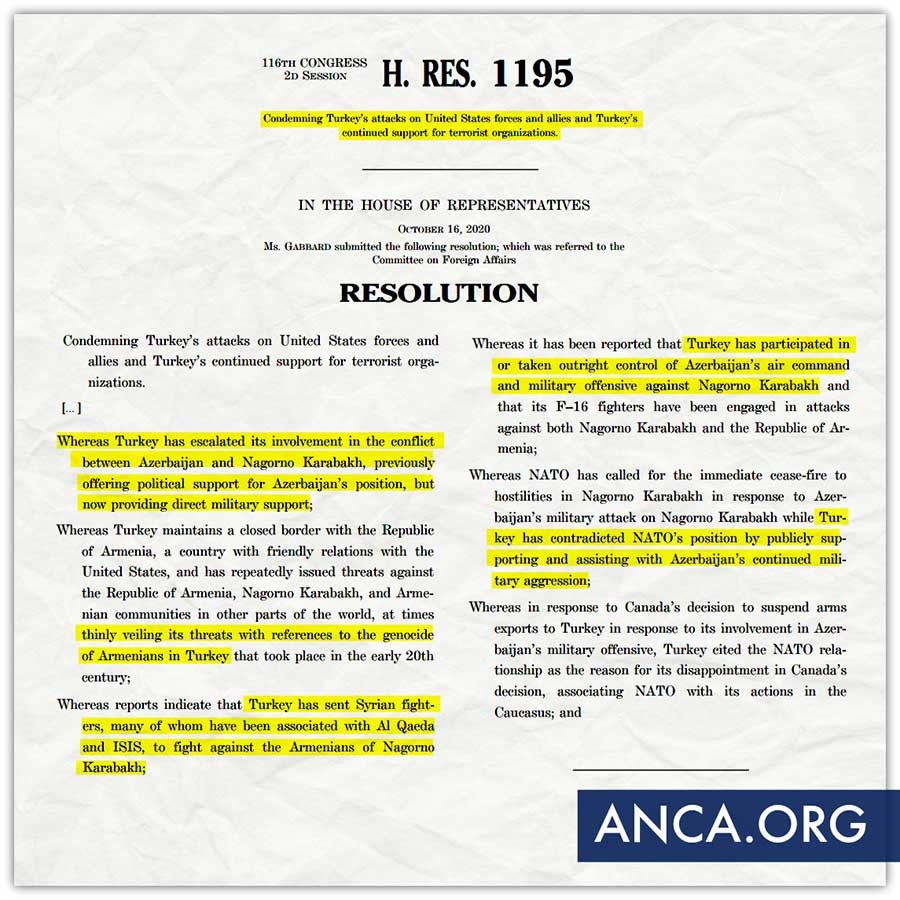
Action expected in recent months has begun to find its logical explanation in the actions of Ms. Tulsi Gabbard, a congresswoman and member of the US House of Representatives. Ms. Gabbard submitted a resolution to the US House of Representatives to expel Turkey from NATO.
The news was officially announced and confirmed by the Armenian National Committee of America [ANCA] and quickly toured the Armenian community, which welcomed the resolution with approval and understanding.
The resolution clearly describes the motives of congresswoman Gabbard that prompted her to write it. Among the main reasons are Turkey’s involvement in the Nagorno-Karabakh conflict and the apparent military support Azerbaijan receives from Ankara in the conflict, and the attraction of terrorists from terrorist groups al-Qaeda and Islamic State as mercenaries participating on the side of Turkey and Azerbaijan. Another reason also cited in the request for Turkey’s expulsion from NATO is the participation of a Turkish F-16 fighter jet in hostilities, both in the skies over Nagorno-Karabakh and in the skies over Armenia.
The motive in the document regarding the last reason is interesting – the Turkish F-16 fighter. The document contains the phrase “whereas it has been reported”, which may mean that US military intelligence also has information supporting the thesis of the participation of the Turkish Air Force in the downing of the Armenian Su-25.
“And this is the case when NATO calls on the countries to cease hostilities and resolve the issue through negotiations,” the document said.
The submitted document also mentions a fact that BulgarianMilitary.com announced only a day ago and that is the decision of Canada to suspend military supplies to Turkey on the basis of the country’s participation in the military conflict in Nagorno-Karabakh. We remind you that Ottawa has decided to stop the supply of military equipment related to technologies for the construction of unmanned aerial vehicles in the direction of Ankara. Turkey has already responded to Canada’s action, citing an agreement between NATO members.
What do we need to know about Congressman Tulsi Gabbard?
She is a former US Army veteran who has missions in Iraq, as well as a US National Guard officer. Its political ideology and line is focused on opposing Washington in various military conflicts that affect the sovereignty of countries around the world. Therefore, it is not surprising that she has criticized the Trump administration for policies against Iraq, Libya and Syria. America still remembers her secret visit to Syria in 2017 and the organized meeting between her and Syrian President Bashar al-Assad, which provoked a lot of criticism in her homeland.
So far, Armenia has responded to Turkey’s attempts to influence regional policy. According to the Armenian government, Turkey’s main goal is to control energy sources in the region, as well as to “arrange” a new genocide against the people of Armenia and to control migration flows in the Caucasus. In this way, Ankara is looking for opportunities for widespread influence not only in the region, but also in Europe, Central Asia, North Africa and the Caspian region.
The situation in Nagorno-Karabakh escalated on September 27, active clashes are taking place in the disputed territory. Martial law was introduced in Azerbaijan and Armenia, and mobilization was announced. Both sides reported killed and wounded, including civilians. In Baku, they announced the control of several Karabakh villages and strategic heights. Yerevan also reports about the shelling of the territory of Armenia.
Nagorno-Karabakh conflict
Azerbaijan and Armenia have been in conflict over Nagorno-Karabakh since February 1988, when the Nagorno-Karabakh Autonomous Region announced its withdrawal from the Azerbaijan SSR.
During the armed conflict in 1992-1994, the Azerbaijani side lost control of Nagorno-Karabakh and the seven areas adjacent to it. Since 1992, negotiations have been conducted within the framework of the OSCE Minsk Group on a peaceful settlement of the conflict. The group is led by co-chairs – Russia, USA and France.
In 1994, Azerbaijan, Armenia and the unrecognized Nagorno-Karabakh Republic, through the mediation of Russia, signed the Bishkek Armistice Protocol. At the same time, military operations did not stop there, which periodically renewed.
The most significant exacerbation of the conflict was the four-day war of 2016. Then hundreds of soldiers on both sides became victims.
Russian Foreign Minister Sergei Lavrov, during a meeting with the President of Azerbaijan last year, called for a rhetoric that would go against the fundamental principles endorsed by both sides and enshrined in the UN Charter and the Helsinki Final Act when resolving the situation around Nagorno-Karabakh. At the same time, the head of the Russian Foreign Ministry admitted that much more needs to be done to achieve a long-term political settlement.
